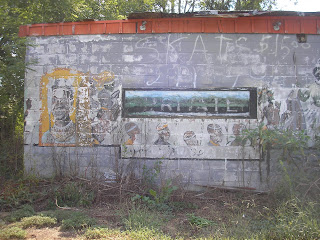


The West Texas town of Wink in the Permian oil patch produced one of the greatest voices in music, Roy Orbison. Although Roy's been gone awhile, it took even longer for Wink to recognize their hometown boy. There is a museum dedicated to Roy in Wink and now, finally, formal recognition has come in the form of an historic marker, according to this article from my friend and colleague Jimmy Patterson of mywesttexas.com, the website of the Midland Reporter-Telegram:
(click on the headline to link to his site):
Wink finally receives historic marker commemorating favorite son Roy Orbison
Walt Quigley with Wink's new Roy Orbison historical marker.
By Jimmy Patterson
Online Editor
Published: Saturday, October 17, 2009 1:35 AM CDT
WINK -- Walt Quigley finally met his marker. After two years of lobbying the Texas Historical Commission, convincing them that Roy Orbison was indeed worthy of his own marker, history arrived his week, perpetuating the legendary rock and roll performer on an iron sign that reads simply “ROY ORBISON” at the top. (Related story: Quigley turns attention to refurbishing historic theater in Wink.)
With over 60 financial supporters also recognized for their efforts at the site of the marker, Quigley said the dedication of the sign was the culmination of months and months of hard work.
“This is the location of one of the homes Roy lived in as a boy,” Quigley noted. “His mom lived here until 1961, when urban renewal took many of the homes and some of the businesses away in Wink during that time.”
Not only did Quigley have to prove to the Texas Historical Commission Orbison's significance and contribution to Texas history and music history, he also had to prove that where the sign would be planted would in fact be where his boyhood home once stood. Such an effort, Quigley said, required much documentation.
All that is left on the site now is a vacant field where the house once stood, but Quigley hopes to one day find a proxy house that can be moved onto the property to, he said, give Orbison fans something to visualize about where Orbison’s home once stood.
Quigley, a transplanted Arizonan who now splits time between a home in Lake Havasu City, Ariz., and Wink, performing in both regions as an Orbison karaoke tribute artist, began working on the marker over two years ago out of his fondness for a singer he said was forever “a true gentleman.” As the marker arrived in Wink last week, Quigley’s efforts to immortalize the Rock and Roll Hall of Famer who influenced everyone from the Beatles to Elvis to Bruce Springsteen, have more to do now with perpetuating on the singer’s legacy for future generations.
“When you think how quickly time is passing, you realize these things have to be done in a timely manner,” said Quigley, who never met Orbison. “I think had we waited any longer, some of the interest may have been lost. The people living now appreciate Roy more and should leave his memory to future generations, where the interest might not lie as much, so it’s important we do these things in our time.”
----
TEXT OF ROY ORBISON MARKER
Text taken from "ROY ORBISON" historical marker, issued by the Texas Historical Commission and designated last week in Wink:
Roy Kelton Orbison was one of America's most famed rock and roll musicians. Born in Vernon (Wilbarger Co.), Orbison and family moved often and by 1946 they had settled in Wink. The Orbisons lived at 102 Langley Way (now 105 N. Roy Orbison Drive). As a high school student in Wink, Orbison formed his first band, the Wink Westerners (later The Teen Kings). He attended North Texas State University at which time the Teen Kings recorded "Ooby Dooby," a song which led to their signing by Sun Records in 1956.
By the early 1960s, Orbison had signed with Monument Records, where he had his greatest commercial success, recording songs like "Only the Lonely (Know The Way I Feel)," "Crying," "In Dreams," "Running Scared" and "Oh! Pretty Woman." By this time Orbison had perfected his unique, powerful singing voice, while focusing on complex melodies in his music. He also began to wear his familiar dark sunglasses during performances.
By the mid-1960s, though, Orbison's career languished. In addition, he suffered a number of personal tragedies. In 1966, Orbison's wife Claudette (Frady) died in a motorccle accident; two years later, two of their three sons died in a fire; in 1969, Orbison remarried. He would have two more sons. In the late 1970s, other artists began covering Orbison's music and by the late 1980s, his career was revived. Orbison was inducted into the Rock and Roll Hall of Fame in 1987. In 1988, he recorded the album "Mystery Girl," which included the hit, "You Got It." Before it was finalized Orbison died unexpectedly of a heart attack. The album was released posthumously and was a success. Today, Orbison continues to be remembered for his legacy of music, which has inspired generations of successful musicians.
Copyright © 2009 - Midland Reporter-Telegram












